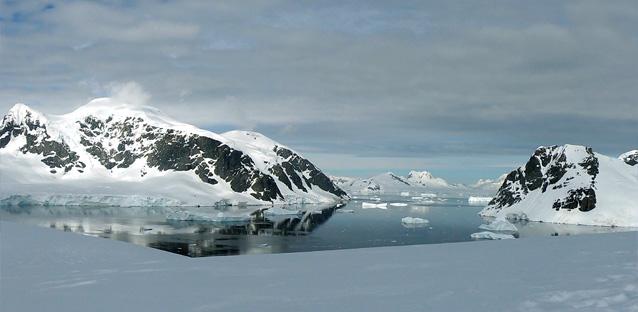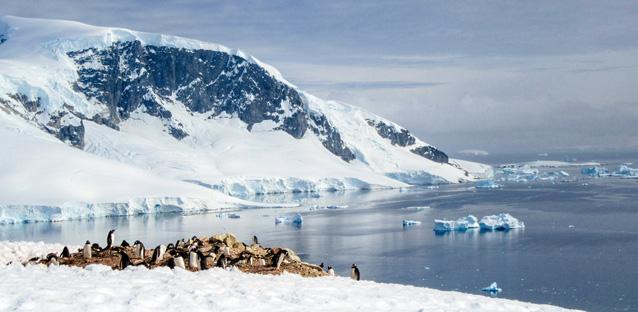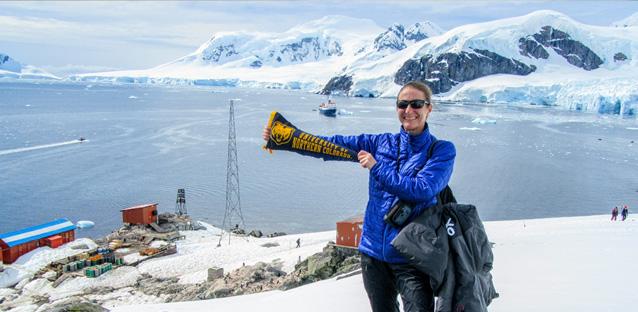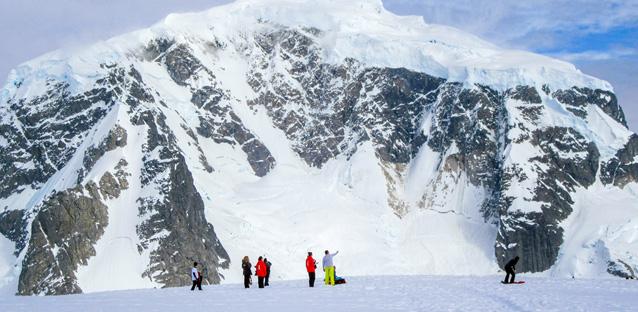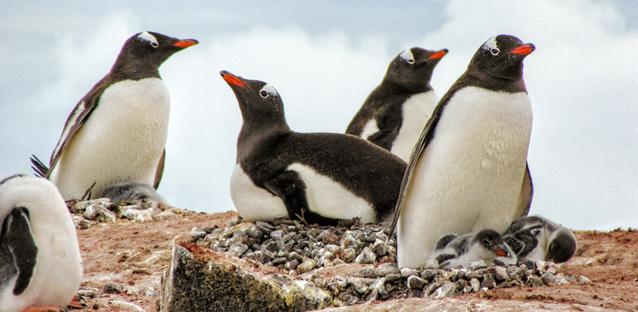Witnessing change on the Antarctic Peninsula
One of the last things I expected to happen in Antarctica was that I would work up a sweat. On a bright, austral summer day, the Antarctic Peninsula, despite the snow and ice, can become much warmer than Colorado on a winter’s day. On this balmy January day, I happened to be trekking up a steep hillside in slushy snow, roasting beneath two layers of fleece pants, a set of black plastic rain pants and a heavy jacket that would probably keep me warm on the coldest of winter days in Colorado. Is this the picture of Antarctica I will share with my students when I get home?
I looked back down the hill to a trail of women behind me, zigzagging up the slope single-file, careful not to leave more footprints than necessary in this frozen paradise, and careful to avoid penguins from the nearby Gentoo colony as they waddled from their nests down to the sea and back again. We were visiting Danco Island, a small, snow-covered hill rising up in the middle of the Gerlache Strait on the west side of the Antarctic Peninsula. We were here together on the culminating adventure of a year-long international professional development program for women in STEMM (Science, Technology, Engineering, Math and Medicine) called Homeward Bound.
The aim of Homeward Bound is to raise the status of women in science and empower them to step into leadership roles related to making decisions that lead to a more sustainable future for our planet. The professional development program is centered around four themes: leadership development, visibility, strategy and scientific collaboration. I was one of 80 women from 18 countries selected to participate in the third expedition to Antarctica. There are seven more expeditions planned over the next six years with the aim of building a global network of 1,000 women supporting each other in science and leadership roles.
As someone who has studied past climate, visiting Antarctica is a dream. Gazing out at the mountains lining the Gerlache Straits, I felt like not only had I arrived at the end of the Earth, but that I had stepped back in time to the peak of the last Ice Age. The ice here can carve out deep valleys and move rocks thousands of miles. There are mountains topped with layers and layers of snow that look like icing on a birthday cake. There are so many glaciers in Antarctica, that, unlike other parts of the world, they don’t have names. I imagined a similar view off the coast of Newfoundland, 20,000 years ago, just before the world warmed up.
Antarctica is one of the most pristine and fragile places on the planet, and it is marvelous.
But it is undergoing deep and rapid transformation. In the latter part of the 20th century, the Antarctic Peninsula warmed by about 1 degree Fahrenheit. While that may not sound like much, that can have huge consequences for ice volume and wildlife. That warming has slowed in recent years, thanks to shifting regional climate patterns, but it is expected to accelerate again in the near future if greenhouse gases continue to rise. Anyone who works on a ship that frequents the Peninsula can tell you how they’ve seen the glaciers retreat in the past 10 years. As a scientist, I find what is happening here sad and also fascinating.
I have spent more than 20 years studying climate and teaching my students how Earth’s climate system works. Climate change is one of the biggest, most complex problems we have ever faced as a species, and its effects can be catastrophic. It’s easy to feel overwhelmed and depressed by an issue of this magnitude. But I want to find a way to walk into my classroom and present climate change as an opportunity, not the disaster it is. I want to fuel my students with the hope that they can be part of the solution. That’s why I applied to Homeward Bound. I wanted to be part of a professional network of women scientists working across disciplinary and national boundaries to find solutions.
Collaborating for Understanding
Participating in the Homeward Bound expedition to Antarctica, UNC Meteorology Professor Cindy Shellito departed from Ushuaia, Argentina, Dec. 31, and returned to campus Jan. 28. Shellito said she applied for the initiative because she is drawn to interdisciplinary collaborations and is committed to finding new, more effective ways of teaching and sharing science, especially the science of climate change. Antarctica serves as the natural backdrop for collaborative work on climate change because it represents the relative fragility of the natural world and is highly sensitive to changes in global temperature.
“I want to better prepare students at UNC for life in the 21st century, which will involve making some tough decisions about how to respond to climate change,” she said, adding that UNC is poised to be a leader in environmental education. She hopes to use her professional development in this program, particularly that related to improving visibility and outreach, to better promote the types of programs and opportunities at UNC.
Shellito has studied climate change for nearly 25 years. Much of her work has focused on using computer models of climate to try to reconstruct what the climate of Earth was like 50 million years ago, when Earth was much warmer than it is today. During that time, the Earth was so warm, in fact, that Antarctica was covered by large swaths of forest. She also studies weather and climate change in the Andes of southern Ecuador, where she spent her sabbatical in 2015 after receiving a Fulbright award.
“Warming is not a new thing for the Earth,” she said, “But it is new for us. We evolved, and our civilizations evolved, in some of the coolest climates of the past 65 million years. And now, our activities are warming the Earth at a rate that is much faster than anything we’ve seen in the geologic record.”
–Katie-Leigh Corder
Most of our program was carried out online through Zoom calls and chat forums by a group of 10 program faculty who are experts in leadership training, visibility, communication and science. The program continued once we began our three-week journey by ship together, but being in Antarctica meant adding elements of surprise and flexibility to our days. We quickly lost track of the number of lectures or workshop activities that were interrupted by shouts of “Whale!” Each day, we took breaks from our program to see penguins leaping through the water. There were moments when we paused just to watch the mist hugging the mountains as our ship glided through black waters toward some secluded bay. I often felt like I was in a fairy tale, or on another planet.
Self-awareness is at the heart of effective leadership and one of the recurrent themes in our Homeward Bound discussions over the past year was learning to listen to ourselves. Sometimes, however, it takes stepping outside of your life and turning off the outside world to do that. Christiana Figueres was one of our Homeward Bound faculty. She is the former executive secretary of the United Nations Framework Convention on Climate Change (UNFCCC), and orchestrated 175 nations to sign the Paris Climate Agreement in 2016. She is one of us on this journey — gathering for meals with us, attending workshop sessions and sharing her own experiences and growth as a leader. “I’d like to invite you to experience silence today,” she said at our briefing before landing at Danco Island. “Antarctica has many tonalities of silence. I’d like to invite you to experience that.”
Silence was hard to come by on a ship with 90 women who were excited and passionate about sharing their lives and dreaming up a better world. But as we climbed the hill on Danco, the only sounds were the swishing of our jackets, the slosh of our boots on wet snow, and the chatter of the Gentoos. As we approached the top of the island, even the Gentoos faded into the background as we took in a panoramic glacial view. The water on the shore of the other side of the island was as smooth as glass and reflected cream-topped mountains. The world shimmered in shades of blue, silver and grey against copper-colored rocks in the mountains off in the distance.
I pulled off my weighty jacket and felt the sun burn my face despite layers of sunblock. It felt like a March day high in the Rockies. At some point, the silence was broken by a rumble off in the distance. I held my breath and looked around, but the world was perfectly still. I heard another rumble. Then another. There were glaciers calving in the distance, too far to see, or hidden from view. “This is the sound of climate change,” I thought.
With that sound I felt a new resolve — a resolve to talk and teach about climate change in a way that highlights opportunity. A resolve born from the collaborative nature of our trip together, from living on a ship full of women who are open and honest about communicating what it means for them to see the world change. A resolve born from hearing stories about what it took to bring about the Paris Agreement, the largest international agreement ever. These things give me a glimmer of hope, and insights into how we solve this global challenge.
Ultimately, it’s about collaboration. Collaboration on a scale that we have never seen. And it starts by listening to ourselves. This is what I want to share with my students. UNC
–Story and Photos by Cindy Shellito, Ph.D., Professor of Meteorology, Earth and Atmospheric Sciences

